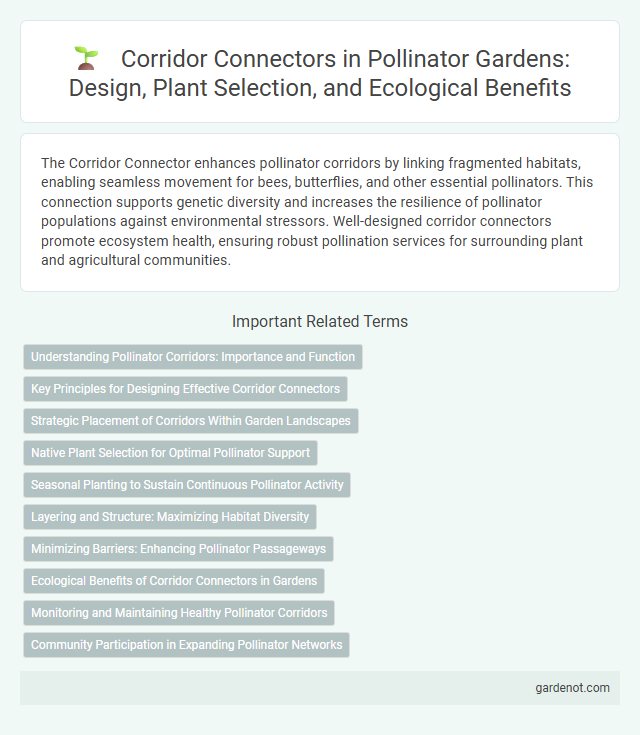The Corridor Connector enhances pollinator corridors by linking fragmented habitats, enabling seamless movement for bees, butterflies, and other essential pollinators. This connection supports genetic diversity and increases the resilience of pollinator populations against environmental stressors. Well-designed corridor connectors promote ecosystem health, ensuring robust pollination services for surrounding plant and agricultural communities.
Understanding Pollinator Corridors: Importance and Function
Pollinator corridors serve as vital ecological connectors that facilitate the movement and genetic exchange of pollinators such as bees, butterflies, and hummingbirds across fragmented habitats. These corridors enhance plant-pollinator interactions by linking floral resources, nesting sites, and breeding grounds, thereby supporting biodiversity and ecosystem resilience. Effective corridor design relies on understanding habitat quality, spatial configuration, and species-specific pollinator behaviors to maximize conservation outcomes and agricultural productivity.
Key Principles for Designing Effective Corridor Connectors
Effective corridor connectors prioritize uninterrupted habitat continuity to support pollinator movement and genetic exchange. Incorporating native flowering plant species with staggered bloom times ensures consistent food resources, enhancing pollinator foraging efficiency. Designing corridors with varied microhabitats and minimal pesticide exposure fosters resilient pollinator populations and biodiversity conservation.
Strategic Placement of Corridors Within Garden Landscapes
Strategic placement of pollinator corridors within garden landscapes enhances connectivity between fragmented habitats, supporting pollinator movement and biodiversity. Positioning corridors near native flowering plants, water sources, and sheltered areas maximizes resource availability and protection for key pollinator species like bees, butterflies, and hummingbirds. Integrating these corridors with existing green spaces and avoiding barriers such as paved pathways promotes continuous pollinator travel and gene flow.
Native Plant Selection for Optimal Pollinator Support
Selecting native plants such as milkweed, goldenrod, and bee balm enhances the effectiveness of pollinator corridors by providing essential nectar and pollen sources tailored to local pollinators. Incorporating a diverse mix of flowering species that bloom sequentially from spring through fall ensures continuous food supply for bees, butterflies, and hummingbirds. This strategic native plant selection fosters habitat connectivity and supports robust pollinator populations critical for ecosystem health and crop pollination.
Seasonal Planting to Sustain Continuous Pollinator Activity
Corridor connectors rely on strategic seasonal planting to maintain continuous pollinator activity throughout the year, ensuring vital nectar and pollen sources remain available as plant species bloom sequentially. Incorporating native wildflowers, flowering shrubs, and early-blooming trees creates an uninterrupted habitat that supports diverse pollinator populations such as bees, butterflies, and hummingbirds. This approach enhances ecological resilience by linking fragmented habitats and promoting pollinator movement essential for biodiversity and ecosystem services.
Layering and Structure: Maximizing Habitat Diversity
Corridor connectors employing layering and structure enhance pollinator habitat diversity by integrating multiple vegetation strata, from ground cover to canopy plants. This vertical complexity supports various pollinator species with differing habitat requirements, improving foraging, nesting, and shelter opportunities. Diverse plant layers also bolster ecosystem resilience by fostering a wider range of pollinator interactions and ecosystem services.
Minimizing Barriers: Enhancing Pollinator Passageways
Corridor connectors play a crucial role in minimizing barriers for pollinators by linking fragmented habitats and ensuring continuous passageways for species like bees, butterflies, and hummingbirds. Strategic placement of native flowering plants and sheltered pathways enhances movement and reduces exposure to predators and harsh environmental conditions. These connectors improve genetic diversity and ecosystem resilience by facilitating pollinator access across urban, agricultural, and natural landscapes.
Ecological Benefits of Corridor Connectors in Gardens
Corridor connectors in gardens enhance biodiversity by linking fragmented habitats, allowing pollinators like bees and butterflies to forage and migrate safely across urban and suburban landscapes. These green pathways improve genetic diversity among plant populations by facilitating cross-pollination between isolated flower patches. Establishing corridor connectors supports ecosystem resilience, promoting natural pest control and sustaining pollination services essential for food production.
Monitoring and Maintaining Healthy Pollinator Corridors
Monitoring pollinator corridors involves regular surveys of species diversity and abundance to track ecosystem health and identify potential threats. Maintaining these corridors requires habitat restoration, invasive species control, and planting native flowering plants to support pollinator nutrition and reproduction. Effective management enhances connectivity between fragmented habitats, promoting genetic diversity and resilience in pollinator populations.
Community Participation in Expanding Pollinator Networks
Community participation plays a crucial role in expanding pollinator corridors by fostering local stewardship and collaboration among residents, schools, and environmental organizations. Engaging diverse stakeholders through workshops, planting events, and citizen science projects strengthens habitat connectivity and promotes biodiversity. These collective efforts increase the availability of resources such as nectar, pollen, and nesting sites, enhancing pollinator movement and resilience across fragmented landscapes.
Corridor connector Infographic

 gardenot.com
gardenot.com